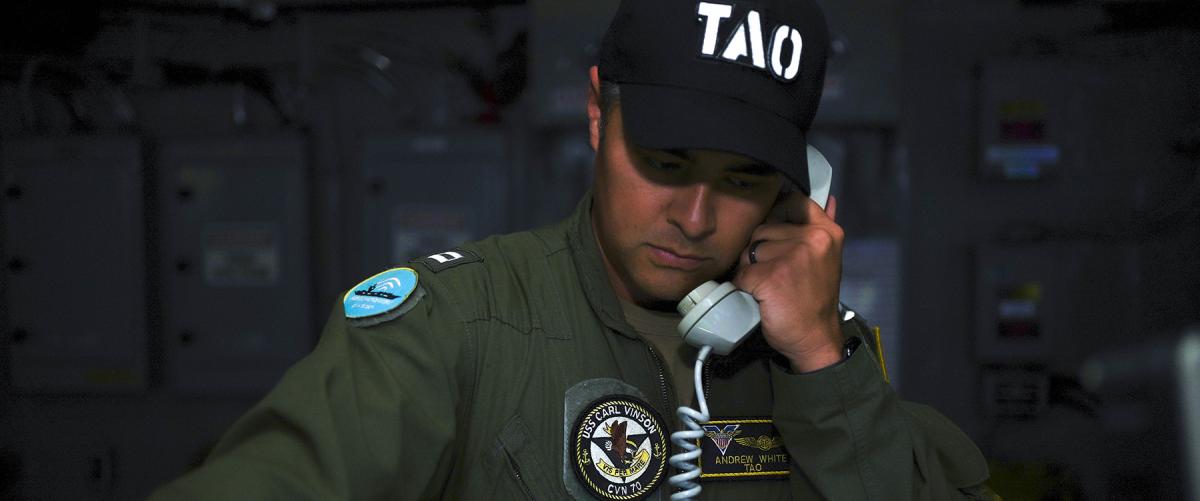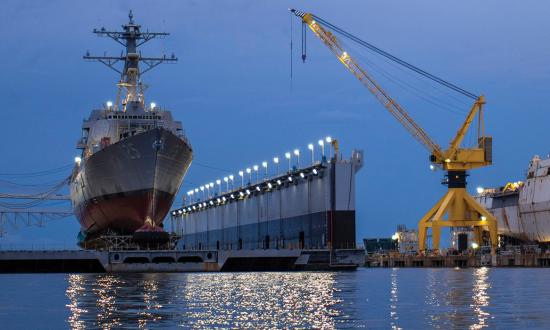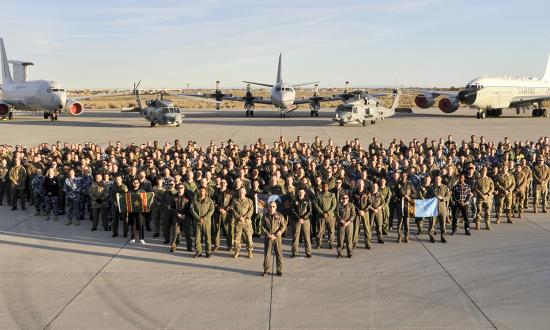To prepare for the high-end fight, U.S. Navy ships must make greater investments in counter–adversary intelligence, surveillance, reconnaissance, and targeting (C-ISRT). This includes improving preparation and execution, from research to briefs to watch team organization—all within the power of commanding officers, though needing support from off-ship organizations.
Culturally and within the daily battle rhythm, ships must seek greater knowledge in communications, datalinks, and electronic warfare, while being supplemented with operations/intelligence briefs up to the top secret/sensitive compartmented intelligence (TS/SCI) level. Tactical action officers (TAOs) must defer to their combat information center watch officers (CICWOs) communicating with other ships by internet chat and stand TAO watch from the ship’s signal exploitation space (SSES). Ships could be endangered if key watchstanders do not have the right information at the right classification.
The surface navy has neglected communications, datalinks, and electronic warfare in the post–Cold War era, in which the U.S. Navy has enjoyed uncontested use of the electromagnetic spectrum and had many “hard-kill” capabilities against adversaries.
The current junior officer billet distribution on board Aegis destroyers underscores this assessment. Whereas the air and undersea warfare missions are staffed with second-tour division officers, the communications officers and electronic warfare officers are first-tour surface warfare officers with just two weeks of specialty training. They rely on operations technician limited duty officers and their midgrade junior enlisted personnel to manage complex datalinks as tactical information coordinators.
Train and Prepare at the Highest Classification Level
Today’s contested electromagnetic environment, especially in the western Pacific, and the generational improvements brought to the fleet with the Surface Electronic Warfare Improvement Program (SEWIP) require a reprioritization and new mission ownership in surface warfare.1 While junior, tactical information coordinators are “coordinators” and as important to any kill chain as junior officer antiair warfare coordinators firing weapons. Similarly, EW operators are far more likely to play primary vice supplementary roles in developing recognized air and maritime pictures. The surface navy must look to naval aviation, where every pilot flies with full knowledge of the aircraft’s capabilities and unrestricted line officers in the EA-18 Growler community are responsible for EW tactics development.
Throughout the predeployment training cycle, shipboard trainers and assessors must better specify not only the source of targeting and the weapon employed for kill-chain demonstrations, but also the entire lifecycle from firing orders to battle damage assessment—including how that information will be shared across the surface force. This will require watchstanders and their off-ship trainers to be cleared to the TS/SCI level. If they are not reviewing threats on the TS/SCI Joint Worldwide Intelligence Communication System, they are not adequately preparing themselves or their ships for the challenges of modern combat. Rather than recreating new TS/SCI briefs, however, ships’ intelligence specialists can use the existing intelligence work done at ashore maritime operations centers, on board big-deck ships, or at warfare development centers.2 Including these TS/SCI intelligence briefs as supplements to the secret daily operations/intelligence briefs should be a requirement rather than a luxury for a small number of cleared individuals.
Minimize Watchstander Distraction
Excellent preparation alone is not enough, however. Watchstanders must be put in an environment in which they can concentrate and avoid unnecessary distraction. “Chat” is the ability to communicate via various message chat rooms on the computers at watchstanders’ consoles. Several Proceedings authors have rightly warned that this capability, while useful, frequently distracts watchstanders from monitoring their consoles and operating the combat system.3 In a May 2019 article, Captain John L. Bub Jr. proposed that a single watchstander be responsible for monitoring chat. While enlisted watch supervisors often have more experience managing CICs, ships should mandate that the CICWOs be qualified as the “chat officers”—the sole individuals who will interface with chat across each warfare area.
CICWO is a required qualification on the path to officer of the deck and surface warfare officer qualification, yet there is limited guidance on how best to train and employ CICWOs, who usually have little maritime warfare experience beyond the Basic Division Officer’s Course. Having the CICWO as the “chat officer” would enable primary watchstanders to focus on their systems with fewer distractions. In addition, if CICWOs sit at a console, they can monitor chat and still back up the bridge by producing automated closest-point-of-contact recommendations or direct that maneuvering-board solutions be completed. Delegating this watchstanding function from TAO to CICWO would enable the TAO to focus on warfighting, especially in a C-ISRT environment. The CICWO junior officer would learn more about each warfare area without having to formally do a warfare coordinator’s job or make verbal off-ship reports.
Operate at the Highest Classification Level
Finally, and most controversial, Aegis ship TAOs must practice operating from the SSES. The SSES is the primary TS/SCI space where cryptologic technicians (collection) work. At present, these technicians “sanitize” TS/SCI information by stripping source data and then passing “indications and warning” voice reports to the TAO in the secret-level CIC. Making CICs sensitive compartmented information facilities is likely untenable because of manpower, security, and network costs and concerns.
Other long-term—albeit expensive—solutions may exist but cannot be fielded in the near term absent creative changes to multiple ship watchstations. Nor are there sufficient TS/SCI-coded junior officer billets to maintain a TAO (much less warfare commanders or their watchstanders) in both SSES and CIC persistently in a wartime environment when factoring in fatigue.4
With better combat system automation and system setup, TAOs could more easily control these systems remotely while in SSES or, if needed, return to CIC in seconds for deliberate engagements. There is a reasonable desire at all levels to control Aegis to avoid inadvertent missile launches. Yet, as Captain Wayne Hughes’ maxim to “fire effectively first” presumes, “effective” means within the tactical and operational contexts of ship employment—ships must know when and why to shoot, not merely because Aegis is providing that recommendation. In a high-end fight, the best way to not waste Aegis ships and their missiles is with TAOs in SSES informed by higher classification briefs and research before assuming their watch, not doing chat in CIC.
As the surface navy continues to prepare for a major conflict and mitigate its C-ISRT risks, continued shipboard experimentation would allow for the best ideas to flourish and eventually become doctrine. Throughout the many phases of a ship’s life, there are opportunities to try different functions while mitigating risk in other ways. Failure to ask hard questions does not make risk go away. The Navy must not wait for war to come to try for the first time what may be necessary and to critique it as thoroughly as it does the most basic training and administrative shipboard functions.
1. C. Todd Lopez, “As in Other Domains, U.S. Use of Electromagnetic Spectrum Is Contested,” DoD News, 20 May 2020; and Sam LaGrone, “Navy Destroyer Modernization Program Could Cost $17B, Take Up to 2 Years Per Hull,” USNI News, 31 January 2023.
2. For more information on the challenges of ship’s intelligence officers, see CPO John Minor, USN, “Revitalize the Enlisted Ship’s Intelligence Officer Program,” U.S. Naval Institute Proceedings 148, no. 11 (November 2022).
3. CAPT John L. Bub Jr., USN, “Watchstanders Can’t ‘Chat’ and Fight the Ship,” U.S. Naval Institute Proceedings 145, no. 5 (May 2019).
4. LT Kyle Cregge, USN, “SWOs Need Higher Classification Training Pipelines,” U.S. Naval Institute Proceedings 149, no. 4 (April 2023).







